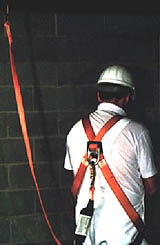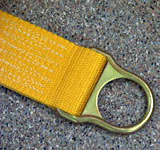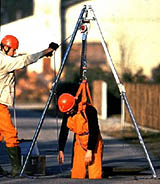Shipyard Employment eTool
Shipbreaking >> Use of Personal Fall Protection Systems

Potential Hazards
- Falls caused by failure to use fall protection
- Injuries due to improper use of fall protection equipment
Requirements and Example Solutions
- When guardrails and other positive fall protection are not available to protect from falls, workers must use personal fall protection systems (such as harnesses, lanyards, lifelines). [29 CFR 1910.67, 29 CFR 1915.71, 29 CFR 1915.73, and 29 CFR 1915.77]
Training
- Before use, workers must be trained to understand [29 CFR 1915.159(d), 29 CFR 1915.160(d)]:
- The application limits (for example maximum permitted free falls, distance needed below to stop before hitting lower levels or objects, minimizing swing falls, etc.) of the equipment
- Proper hook-up, anchoring, and tie-off techniques
- Proper use, inspection, and storage of equipment
- Personal fall protection systems must not be used for other purposes such as hoisting materials. [29 CFR 1915.159(c)(9)]
Inspection
- Personal fall protection systems must be inspected before each use and defective components must be removed from service. [29 CFR 1915.159(c)(5), 29 CFR 1915.160(c)(1)]
- Personal fall protection systems subjected to impact loading must be removed from service. [29 CFR 1915.159(c)(6), 29 CFR 1915.160(c)(2)]
Anchorage
- Workers must attach to an anchorage of sufficient strength (5,000 pounds). [29 CFR 1915.159(a)(9)]
- Workers must use anchorage points independent of the scaffold supporting system. [29 CFR 1915.159(a)(8)]
- Positioning device systems must be secured to an anchorage capable of supporting at least twice the potential impact load of a worker's fall. [29 CFR 1915.160(a)(3)]

Lifelines and Lanyards
- Each worker must be provided with their own separate vertical lifeline. [29 CFR 1915.159(b)(1)]
- Horizontal lifelines must be designed, installed, and used under the supervision of a qualified person. [29 CFR 1915.159(b)(5)]
- Workers must use systems that are rigged to prevent free fall of more than six feet or contact with the lower level. [29 CFR 1915.159(b)(7)]
- Lifelines and lanyards must be protected against damage such as cuts, abrasions, burns (hot work), acids, and solvents. [29 CFR 1915.159(c)(4)]

Snap Hooks and D-Rings
- Workers must use locking snaphooks. [29 CFR 1915.159, 29 CFR 1915.160(a)(4)].
- Snaphooks, unless designed for such connections, must not be connected to: [29 CFR 1915.159(a)(6)]
- Webbing, rope or wire rope
- Other snaphooks
- D-rings to which other snaphooks or connectors are attached
- Horizontal lifelines
- Other objects such as eye bolts that are incompatible

Rescue
- In the event of a fall, prompt rescue of workers must be provided. [29 CFR 1915.159(c)(7)]
Potential Hazards
- Falls due to anchorage or equipment failure
- Injuries (for example damage to internal organs, fractures, abrasions) due to the use of improper fall protection equipment
Requirements and Example Solutions
- Personal fall protection systems must meet the design, strength, and testing requirements for the equipment. [29 CFR 1915.159, 29 CFR 1915.160, and Subpart I Appendix B]
- Design requirements include:
- Maximum permitted arrest forces
- Minimum system strength
- Maximum permitted stopping distances
- Component strength
- Proof testing
- Corrosion-resistant materials
- Compatibility requirements
Additional Resources
- 29 CFR 1910.66 Appendix C, Section III – Additional Non-mandatory.
- Care of Safety Belts, Harnesses, and Lanyards. Canadian Centre for Occupational Health and Safety (CCOHS) (January 16, 1998). A Q&A document regarding the proper care and use of fall protection equipment.

